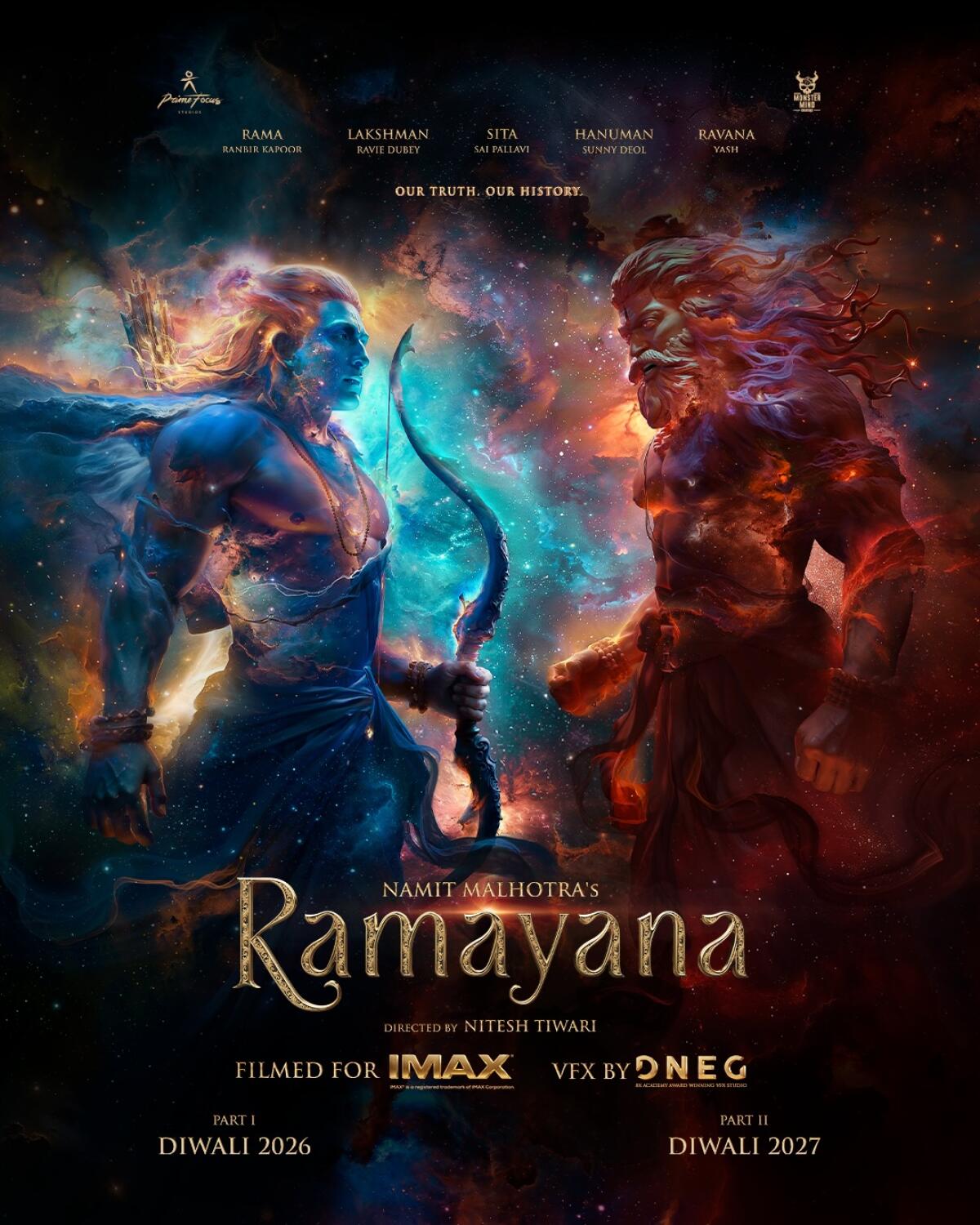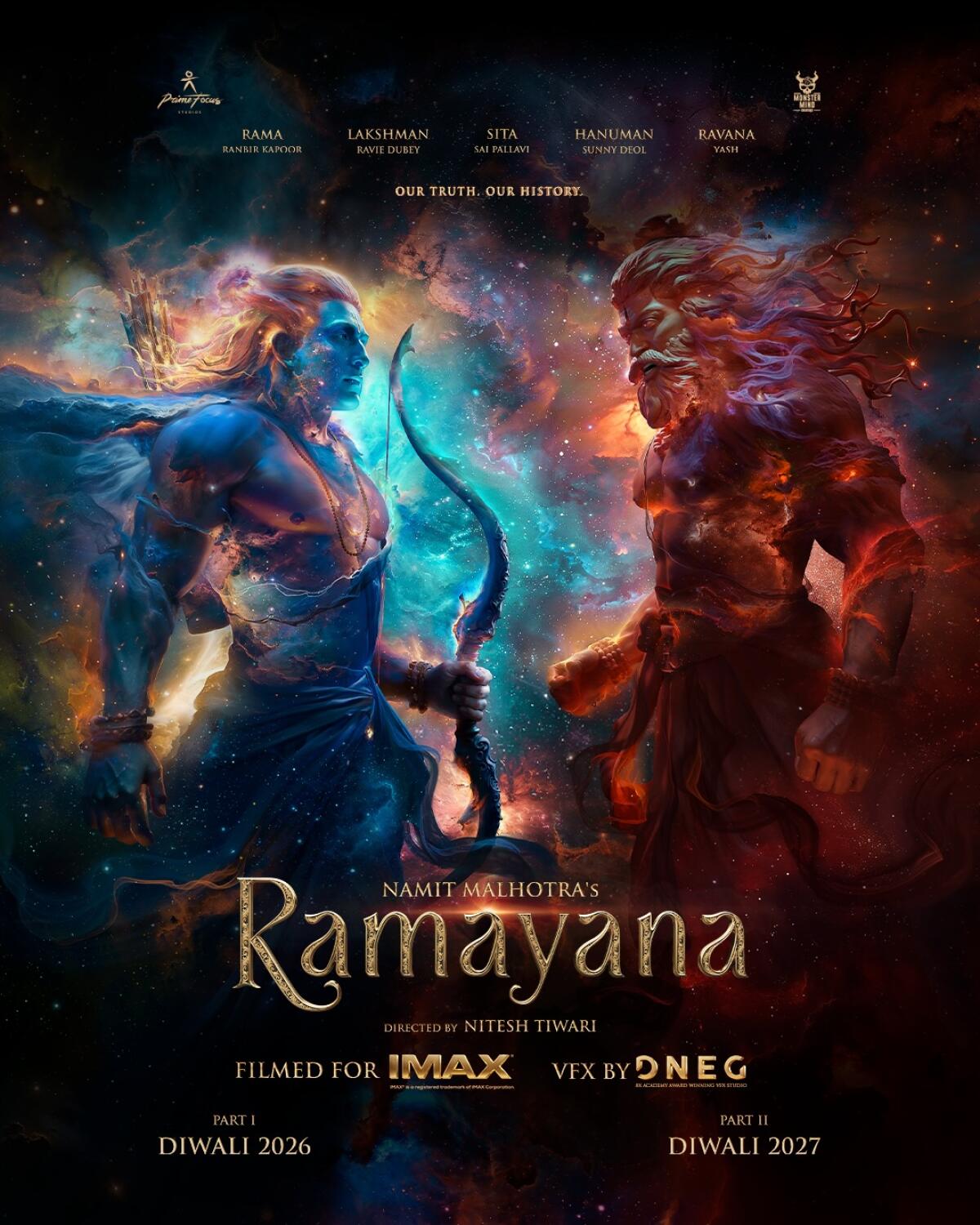Movies from India’s prolific film industry have found success on the world stage before.
“RRR,” an over-the-top Telugu-language action film, energized audiences in the U.S. and elsewhere a few years ago, even scoring a history-making Oscar for its original song “Naatu Naatu.” Hindi screenings have long drawn crowds to American multiplexes.
But the filmmakers behind “Ramayana” — an upcoming two-part epic based on one of the most important ancient texts in Hinduism — have something more ambitious in mind.
The massive productions — each estimated to cost $200 million to $250 million — are aimed not merely at an Indian audience, nor are they meant to appeal primarily to Hindus, who number an estimated 1.2 billion globally, according to Pew Research Center.
Rather, the goal is to turn “Ramayana,” with its grand-scale adventure story and high-tech computer-generated effects, into a full-blown international blockbuster, filmed specifically for Imax’s giant screens in what is intended to be the largest-ever rollout for an Indian film, according to its backers.
Executive Namit Malhotra — who is financing and producing the project through his firm Prime Focus — set the bar high in a recent interview with The Times, comparing his film to the likes of James Cameron’s “Avatar,” Ridley Scott’s “Gladiator” and the movies of Christopher Nolan.
While Hollywood studio bosses talk about reaching all four demographic “quadrants” (men and women, young and old) with their tentpole movies, Malhotra wants to draw two additional categories: believer and nonbeliever. For such a so-called six-quadrant movie to work, to use Malhotra’s terminology, it would have to succeed in the U.S.
“In my mind, if people in the West don’t like it, I consider that as a failure,” Malhotra told The Times recently. “It is meant for the world. So if you don’t like it, shame on me. We should have done a better job.”

Poster art for the upcoming film ‘Ramayana.’
(DNEG)
It’s a major gamble for Malhotra, who founded Prime Focus in Mumbai in 1997. The firm expanded significantly when it acquired British effects house Double Negative, and rebranded as DNEG. Malhotra owns nearly 68% of the parent company, Prime Focus Ltd.
He’s going to great lengths to make sure his big bet pays off. DNEG, headquartered in London with offices in India, Los Angeles and elsewhere, is handling the visuals. The firm has produced special effects for global studio features for years, creating Oscar-winning work for such movies as Denis Villeneuve’s “Dune: Part Two” and Nolan’s “Tenet.”
“Ramayana” is directed by Nitesh Tiwari, the man behind 2016’s “Dangal,” the highest-grossing Bollywood film ever, including huge sales in China. Hans Zimmer and prolific Indian musician-composer A.R. Rahman (“Slumdog Millionaire”) are collaborating on the score, while the visual effects and production design team includes veterans from “Mad Max: Fury Road,” “Avengers: Endgame” and the “Lord of the Rings” franchise.
The success of “RRR,” which told the story of two Indian legends with larger-than-life abilities fighting British imperialism, is one reason Malhotra is confident that “Ramayana” might connect with Westerners more familiar with the Bible and “The Odyssey” (the subject of a much-hyped 2026 Nolan film) than with Hindu mythology. U.S. cinephiles have in the past embraced mythical Asia-set films such as Ang Lee’s “Crouching Tiger, Hidden Dragon” and “Life of Pi.”
So why not “Ramayana?”
After all, family, good vs. evil and personal striving are all key themes that transcend national borders.
“Emotions are universal,” said Tiwari in a video call. “If the audience connects with you emotionally, I think they will connect with the whole story. Emotions have powers to travel across boundaries.”
Filmed entirely on soundstages, the first part of “Ramayana” is scheduled to hit theaters next year, with a significant push from Imax. “Part 2,” currently in production, is planned for 2027. Each part is timed for Diwali, the Hindu festival of lights. The films do not yet have a U.S. distributor.
This comes as Imax has beefed up its clout as what is increasingly seen as a linchpin component for the release of big-screen movies, not just for Hollywood spectacles but also, lately, for local language films. Imax showcased just a handful of Indian movies on its screens in 2019, according to Chief Executive Richard Gelfond. Last year, the company played 15.
So far this year, international films made in their local language have accounted for more than 30% of Imax’s total global box office revenue, Gelfond said. Much of that tally came from “Ne Zha 2,” a Chinese-produced animated film that grossed roughly $2 billion worldwide, mostly from its home country.
As such, Gelfond has high hopes for “Ramayana.” “Judging from what we’ve seen, this has all the elements to be a global success,” Gelfond said.
At its core, “Ramayana,” based on the epic poem from thousands of years ago, tells the story of Hindu deity Rama, an incarnation of the god Vishnu, and his quest to rescue his love Sita from the demon king Ravana.
A three-minute teaser trailer introduced the concept, emphasizing the big names attached (including actors Ranbir Kapoor as Rama, Sai Pallavi as Sita and Yash as Ravana), displaying some “Game of Thrones” opening credits-style visuals and conveying the tale’s historical importance. “Our truth. Our history,” reads the onscreen text. The video has 9.4 million views on YouTube.
“Ramayana” is a quintessentially Indian story. It has been adapted for stage and screen before, perhaps most notably as a series for Indian TV in the late 1980s.
For the new version, Malhotra wants to eliminate any language barriers. DNEG is using syncing technology from its Brahma AI unit to seamlessly present the film in local languages for international audiences. In the U.S., for example, the movie will screen in English.
“It’s a global film from the day we start,” he said. “I’m not trying to make it to appease Indian people in India. … If you go and watch ‘Ramayana’ and your family watches it, and people in India watch it, what’s the difference? It should speak to you like any other film.”
Newsletter
You’re reading the Wide Shot
Ryan Faughnder delivers the latest news, analysis and insights on everything from streaming wars to production — and what it all means for the future.
You may occasionally receive promotional content from the Los Angeles Times.
Stuff we wrote
Number of the week

Airing election misinformation continues to be expensive for cable news networks.
Newsmax will pay $67 million to settle a defamation suit filed by Dominion Voting Systems over false claims about voter fraud in the 2020 election that aired on the right-wing news channel.
The network announced the settlement with the voting equipment maker Monday but did not apologize for its reporting.
Fox News settled a similar case with Dominion in 2023 for $787.5 million after it aired incorrect election claims. Newsmax is much smaller than Fox, which continues to battle a lawsuit from another voting machine company, Smartmatic.

Streaming is getting closer to another major milestone. According to Nielsen’s the Gauge report, streaming services accounted for 47.3% of U.S. TV usage in July, compared with 22% for cable and 18.4% for broadcast. That’s what happens when there’s new “Squid Game” on Netflix and there’s not much on regular TV.
Finally …
Listen: No Joy, “Bugland.” Excellent ’90s-style rock.
